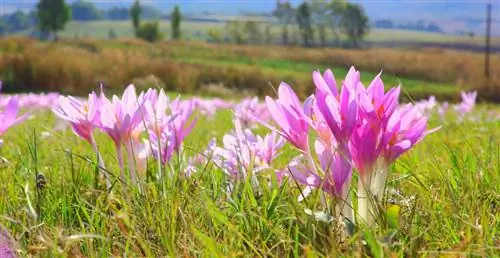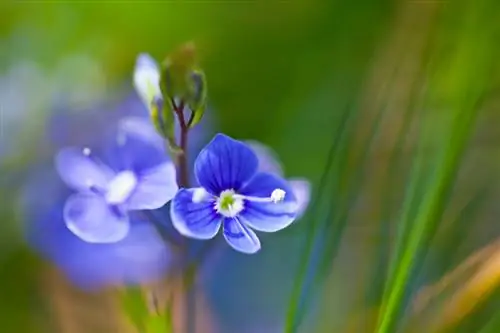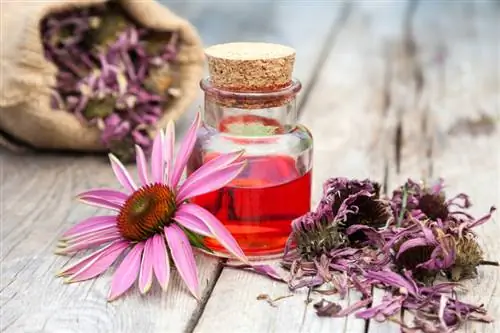- Author admin [email protected].
- Public 2023-12-25 17:45.
- Last modified 2025-01-23 11:22.
With the magnificent spire, even beginners will receive envious glances over the garden fence. In order for the astilbe to transform sunny, partially shaded to shady locations into a summer sea of flowers, the perennial has few requirements. The following answers to frequently asked questions provide what these are and other useful information.

How do you care for an Astilbe?
The Astilbe prefers semi-shady to shady locations with fresh, moist, nutrient-rich and slightly acidic soil. It requires regular watering with lime-free water, organic fertilizer and pruning close to the ground in autumn or spring.
Care tips
If the magnificent spar finds a partially shaded location with fresh, moist, nutritious and slightly acidic soil, half of the way to vital growth has already been achieved. This is how the care program runs smoothly:
- Keep the soil constantly moist with lime-free water
- Fertilize organically every 3-4 weeks from April to August or apply slow-release fertilizer in April and June
- Pruning close to the ground either in autumn or early spring
If the astilbe thrives in the bed, winter protection in the form of a layer of leaves, straw or brushwood is only recommended in the year of planting. In contrast, buckets are wrapped in bubble wrap every year and placed on wood.read more
Which location is suitable?
A look at its natural distribution area shows us that the magnificent spar feels extremely comfortable in the partially shaded protection of mighty deciduous and coniferous trees. The lush perennial tolerates sunny locations provided that the soil is well moist and yet not waterlogged. Plant the astilbe in tuffs along the edge of the wood, on the edge of the pond or along a stream, where the perennial is spared from the blazing midday sun.read more
What soil does the plant need?
The magnificent spar always proves its reputation as a prime example of a shade perennial when this soil condition is available to it:
- Nutritional and humic
- Fresh to moist, without risk of waterlogging
- Well-drained, preferably loamy, without high sand content
- Neutral to slightly acidic pH value of 5.5 to 6.0
As a substrate in the pot, we recommend a high-quality compost-based potting soil with little or no peat content. Adding a handful of perlite or lava granules improves permeability and prevents compaction.
When is flowering time?
The selected variety defines the flowering period of a magnificent spirea. Popular species, such as Astilbe japonica and varieties derived from it, bloom from June to July. Crowd favorites, like the delicate Astilbe chinensis, showcase colorful flower spikes from August to September. The particularly valuable group of Arendsii hybrids does the same and sometimes lasts until October in mild weather.read more
Cut Astilbe correctly
If you cut the perennial back close to the ground after flowering in autumn, this measure saves it the effort of producing seeds. At this point it should not go unmentioned how decorative the seed heads of a magnificent spar are in the spotlight in the early winter garden. If you don't want to miss out on this feast for the eyes, don't prune it until late winter.read more
Watering Astilbe
The top priority for a perfectly regulated water balance is not to allow the root ball of a magnificent spar to dry out at any time. Therefore, check the moisture content of the soil daily using a thumb test, especially during the summer flowering period. If the substrate feels dry on the surface, water it. Apply soft rainwater or decalcified tap water directly to the root disc. However, the beauty of the flowers will take offense at a targeted bombardment with the garden hose.
Fertilize Astilbe properly
The nutrient requirements of a magnificent spar are in no way inferior to the high water requirements. In order for the perennial to produce its opulent flowers and leaves, it must not run out of energy. Fertilize the astilbe organically every 3-4 weeks from May to August with compost (€10.00 on Amazon), horn shavings or horse manure. Alternatively, apply a long-term fertilizer at the end of April/beginning of May, which - depending on the preparation chosen - is refreshed again in July.read more
Wintering
An adult sparrow is completely hardy, so no special precautions need to be taken to ensure he althy overwintering. Regardless, we recommend light winter protection in the year of planting, as a young astilbe still has to gain frost hardiness. Therefore, before the first frost, cover the plant with leaves, straw, needles or garden fleece. In the pot, the root ball is also at risk in later years due to its exposed location. As a precaution, wrap the vessel in bubble wrap. To prevent the cold from finding its way into the root ball from below, slide a block of wood under it. The substrate is given a layer of autumn leaves or peat moss.
Propagate Astilbe
For the ambitious hobby gardener, it is a matter of honor to propagate their perennials on their own. In this respect, the magnificent pier is pleasingly uncomplicated. To grow more specimens, dig up the root ball in autumn or spring and place it on a stable surface. Using a freshly sharpened knife or spade, divide the strong rhizome into two or more segments. Plant the root piece at the new location while maintaining the previous planting depth. As long as a section has at least 2 eyes, it will quickly transform into a vital young plant.
How do I transplant correctly?
At the latest when a magnificent spar becomes bald from the inside, you can no longer avoid replanting it. To do this, dig up the root ball in spring or autumn. Use a sharp, disinfected knife to cut off the bald parts. The remaining segments are planted either at the previous location or at the new location as deep as before.
Is astilbe poisonous?
The magnificent spar is not only a feast for the eyes of young and old, but also provides a rich table of pollen and nectar for bumblebees, bees and butterflies. The astilbe therefore deserves a regular place in the planting plan for the family garden and the naturally designed green realm. This is all the more true because there are no toxic substances in their plant parts.read more
Yellow leaves
If the leaves of a pixie turn yellow, it is usually a reaction to water that is too hard. If lime accumulates in the soil, it prevents the absorption of important nutrients. The result is leaf chlorosis, which appears in yellow leaves. Immediately switch the water supply to collected rainwater, descaled tap water or pond water.
Beautiful varieties
- Bridal veil: magnificent veil in premium quality with white flower bushes and a tightly upright habit up to 100 cm
- Fanal: Impresses with its dramatic appearance thanks to blood-red flower spikes over feathery, shiny green foliage; 60-70cm
- Astary Pink: Magnificent dwarf variety that unfolds its pink flower festival in containers and small gardens; 25-30cm
- White Gloria: Charming splendor, ideal for semi-shady to shady locations; beautiful vase decoration; 60-80cm
- Younique Salmon: The noble beauty scores with salmon-colored flowers over shimmering foliage; 40-50cm






